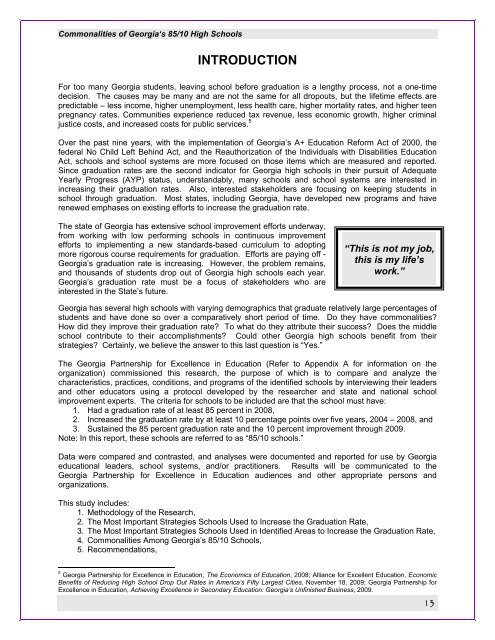Commonalities of Georgia's 85/10 High Schools
Commonalities of Georgia's 85/10 High Schools
Commonalities of Georgia's 85/10 High Schools
Create successful ePaper yourself
Turn your PDF publications into a flip-book with our unique Google optimized e-Paper software.
<strong>Commonalities</strong> <strong>of</strong> Georgia‘s <strong>85</strong>/<strong>10</strong> <strong>High</strong> <strong>Schools</strong><br />
INTRODUCTION<br />
For too many Georgia students, leaving school before graduation is a lengthy process, not a one-time<br />
decision. The causes may be many and are not the same for all dropouts, but the lifetime effects are<br />
predictable – less income, higher unemployment, less health care, higher mortality rates, and higher teen<br />
pregnancy rates. Communities experience reduced tax revenue, less economic growth, higher criminal<br />
justice costs, and increased costs for public services. 5<br />
Over the past nine years, with the implementation <strong>of</strong> Georgia’s A+ Education Reform Act <strong>of</strong> 2000, the<br />
federal No Child Left Behind Act, and the Reauthorization <strong>of</strong> the Individuals with Disabilities Education<br />
Act, schools and school systems are more focused on those items which are measured and reported.<br />
Since graduation rates are the second indicator for Georgia high schools in their pursuit <strong>of</strong> Adequate<br />
Yearly Progress (AYP) status, understandably, many schools and school systems are interested in<br />
increasing their graduation rates. Also, interested stakeholders are focusing on keeping students in<br />
school through graduation. Most states, including Georgia, have developed new programs and have<br />
renewed emphases on existing efforts to increase the graduation rate.<br />
The state <strong>of</strong> Georgia has extensive school improvement efforts underway,<br />
from working with low performing schools in continuous improvement<br />
efforts to implementing a new standards-based curriculum to adopting<br />
more rigorous course requirements for graduation. Efforts are paying <strong>of</strong>f -<br />
Georgia’s graduation rate is increasing. However, the problem remains,<br />
and thousands <strong>of</strong> students drop out <strong>of</strong> Georgia high schools each year.<br />
Georgia’s graduation rate must be a focus <strong>of</strong> stakeholders who are<br />
interested in the State’s future.<br />
“This is not my job,<br />
this is my life’s<br />
work.”<br />
Georgia has several high schools with varying demographics that graduate relatively large percentages <strong>of</strong><br />
students and have done so over a comparatively short period <strong>of</strong> time. Do they have commonalities?<br />
How did they improve their graduation rate? To what do they attribute their success? Does the middle<br />
school contribute to their accomplishments? Could other Georgia high schools benefit from their<br />
strategies? Certainly, we believe the answer to this last question is “Yes.”<br />
The Georgia Partnership for Excellence in Education (Refer to Appendix A for information on the<br />
organization) commissioned this research, the purpose <strong>of</strong> which is to compare and analyze the<br />
characteristics, practices, conditions, and programs <strong>of</strong> the identified schools by interviewing their leaders<br />
and other educators using a protocol developed by the researcher and state and national school<br />
improvement experts. The criteria for schools to be included are that the school must have:<br />
1. Had a graduation rate <strong>of</strong> at least <strong>85</strong> percent in 2008,<br />
2. Increased the graduation rate by at least <strong>10</strong> percentage points over five years, 2004 – 2008, and<br />
3. Sustained the <strong>85</strong> percent graduation rate and the <strong>10</strong> percent improvement through 2009.<br />
Note: In this report, these schools are referred to as “<strong>85</strong>/<strong>10</strong> schools.”<br />
Data were compared and contrasted, and analyses were documented and reported for use by Georgia<br />
educational leaders, school systems, and/or practitioners. Results will be communicated to the<br />
Georgia Partnership for Excellence in Education audiences and other appropriate persons and<br />
organizations.<br />
This study includes:<br />
1. Methodology <strong>of</strong> the Research,<br />
2. The Most Important Strategies <strong>Schools</strong> Used to Increase the Graduation Rate,<br />
3. The Most Important Strategies <strong>Schools</strong> Used in Identified Areas to Increase the Graduation Rate,<br />
4. <strong>Commonalities</strong> Among Georgia’s <strong>85</strong>/<strong>10</strong> <strong>Schools</strong>,<br />
5. Recommendations,<br />
5 Georgia Partnership for Excellence in Education, The Economics <strong>of</strong> Education, 2008; Alliance for Excellent Education, Economic<br />
Benefits <strong>of</strong> Reducing <strong>High</strong> School Drop Out Rates in America’s Fifty Largest Cities, November 18, 2009; Georgia Partnership for<br />
Excellence in Education, Achieving Excellence in Secondary Education: Georgia’s Unfinished Business, 2009.<br />
13


